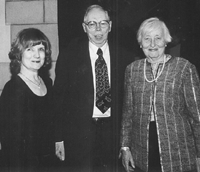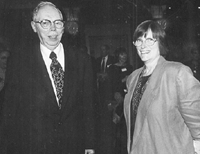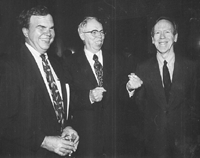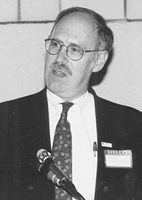A Celebration for Donald J. Lewis
September 23, 1999

Former SIAM and AMS presidents Margaret Wright and Cathleen Morawetz set out to organize an event that would leave Lewis with a sense that his tireless efforts were indeed appreciated by the community. All photographs this page by Marty LaVor.
Admiration, respect, gratitude, and affection were the dominant sentiments of the evening. (Happiness to be returning, finally, to their home in Michigan may well have predominated for Lewis and his wife, Carolyn; called out of his retirement from the University of Michigan, Lewis had agreed to take the NSF position for two years, and then for a third, and finally a fourth.) Bob Eisenstein, head of the Directorate for Mathematical and Physical Sciences at NSF, pronounced the occasion "bittersweet"; Eisenstein was Lewis's boss at NSF and accordingly one of the few speakers allowed on the carefully guarded agenda by the organizers of the event, Cathleen Morawetz and Margaret Wright. (Initially reluctant, Lewis agreed to the event only after being promised a minimal number of speeches.)

Role reversal: Judy Sunley first encountered Lewis as a student in his freshman calculus course at Michigan, 35 years ago this fall. "He wrote so fast on the board," she recalled, "that I had to trade off with a friend, taking notes and taking in what he was writing on the board . . . The median score on the first exam was about 30. . . ." However, she continued, he was a mentor "back when we didn't talk about mentors. . . . He cared about students." Much more recently, when frustrated by the bureaucratic aspects of his job at NSF, Lewis found himself turning to his former student (herself a former DMS director and, as of August, interim NSF assistant director for the Education and Human Resources Directorate).

Jim Crowley and Gil Strang with Lewis, who was formally commended by SIAM for "Service to the Mathematical Sciences," specifically "his inspiring and energetic leadership" of DMS, "his creative and thoughtful strategies for advancing mathematical sciences research, and his dedicated and tireless service on behalf of the mathematical sciences community."
During their coinciding terms (1995-96) as presidents of the American Mathematical Society and SIAM, respectively, Morawetz and Wright forged a close and productive working relationship both with each other and with Lewis. Their considerable esteem for him was evident in the care they took with every detail of the Academy event.

Describing Lewis as "a spokesman for all the sciences during his four years at NSF," Bob Eisenstein (above) also credited him for his encouragement of invigorated, broader, more interdisciplinary programs, the recompetition for institutes, the VIGRE program, the DARPA-NSF initiatives, and an important assessment of U.S. research in the mathematical sciences.
Michigan's mathematics department is still deriving the benefits of Lewis's decade as chair, said current chair Al Taylor, who had been asked to give a short speech. Not at all surprising to those familiar with Lewis's achievements at NSF, Taylor mentioned Lewis's "sense of obligation to share the excitement of research with students," his memorable speech on the bleak future of mathematics departments with a solely internal focus, and an interdisciplinary initiative that added eight positions to the department and made it considerably more outward-looking. Surely gratifying to Lewis, who in many interviews with SIAM News expressed his impatience to get back to research, was Taylor's reference to the sequence of papers (1961-72) on Diophantine equations by Lewis and Harold Davenport that "remains as influential today as when the papers were written."
Bob MacPherson, speaking as chair of the Board on Mathematical Sciences, cited a few of the many innovative programs the community owes to Don Lewis: the VIGRE program, a sabbatical program that gives senior mathematicians the opportunity to go off and learn about other fields, and his tireless quest to find innovative ways to make the best possible use of scarce resources. Many nodded in agreement with MacPherson's assessment of Lewis's approach to his job at NSF: "Don managed to join Washington culture without losing track of the culture of mathematicians who do research."
Presenting a framed commendation to Lewis on behalf of SIAM, SIAM president Gil Strang expressed much the same idea: "What I really admire is that he remained himself, willing to say what was on his mind---well, he remained a mathematician."---GRC

